Although it is a little earlier than usual this year, spring is officially upon us. Last week, we discussed spring ephemerals, their importance to early pollinators, and their symbiotic relationships with various Insecta and Mammalia species. This week, we will talk about the first signs of spring in the bird world: the early bird migrators. When first sighted or heard on a brisk March morning, certain birds immediately tell us spring is upon us. For me, the Red-winged Blackbird is a sure sign of spring. For many others, signs of spring include the iconic v-formation that waterfowl fly in when we look up into the sky, the return of American Robins to our yards listening and searching for earthworms, and Eastern Bluebirds returning to the nest boxes we have built for them.
Each year, thousands of waterfowl migrate to or through Wisconsin. Twenty-four different species of duck, five species of geese, and two species of swan either migrate to Wisconsin in the spring, returning to their breeding grounds or use our beautiful lakes and rivers as a pit stop before their final destination. In fact, the Green Bay Estuary is one of the largest in the world, making it a hot spot for many waterfowl passing through.
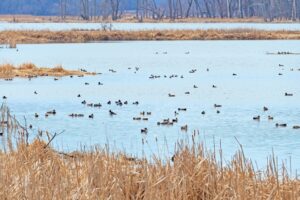
Waterfowl begin their journey north when wetlands start to thaw and snow disappears from the fields. Spring migration comes hand in hand with babies, so bonds between established pairs are strengthened during their flight north, and new pairs are created. On average, when migrating, waterfowl can fly between forty and sixty miles per hour, with some even reaching seventy miles per hour or higher when the winds are in their favor. Many waterfowl will fly in a v-formation during migration, allowing them to conserve energy and communicate with one another. Each bird flies slightly higher than the bird in front of them, reducing the amount of wind resistance. As the leaders tire, they fall back, letting the next in line lead the way.
Even though thousands of waterfowl migrate to or through Wisconsin, over time, some of our waterfowl have become partial migrants. If a bird is a partial migrant, some members of their species will migrate out of Wisconsin during the winter months, and some won’t. This is because our winters are getting milder and milder, allowing access to food year-round. As long as there is open water or exposed grasses, waterfowl such as Wood Ducks, Canada Geese, and Trumpeter Swans have been known to not all migrate south.
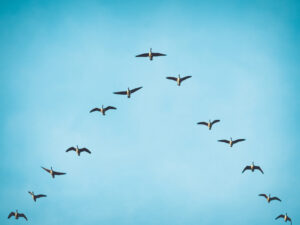
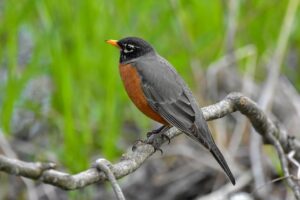
American Robins are one of North America’s most widely known songbirds, so much so that they are the state bird to not just one but three states. Connecticut, Michigan, and Wisconsin all hold a special place in their hearts for this medium-sized songbird. Here in Wisconsin, sightings of robins in the spring give us all the sense that warmer days will soon come. American Robin flocks can fly up to thirty to thirty-six miles per hour during migration, covering roughly one hundred to two hundred miles daily! Unlike waterfowl, where everyone leaves together for spring migration, male American Robins head north earlier than females to choose and defend their nesting territory. The females arrive anywhere from a few days to a few weeks later.
Once the females arrive, they make their nests while the males occasionally give them supplies. After the female lays her clutch, she solely incubates the eggs and then cares for the young. This seems unfair, but the male’s parenting comes later on. American Robins can have up to three broods in a season, so the males take care of their first brood’s fledglings (teenagers). Each night, he takes his teens to a well-sheltered stand of trees where other males also bring their fledglings. Once the new brood hatches, the male leaves the older brood to care for the hatchlings. By this time, the older brood can forage independently, and they already have an established flock with the other teenage robins that had been roosting with them and their dads.
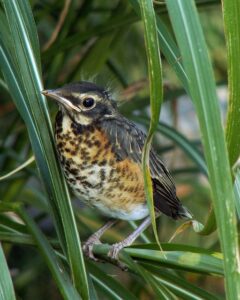
The Eastern Bluebird is a permanent resident in much of the Southern United States. However, for those in the Northern United States and Canada, it is one of the first birds to show up during spring migration and one of the last to leave for the fall migration. Unlike the American Robin, where the males migrate north sooner than the females, the male and female Eastern Bluebird arrive together. They travel in flocks at roughly seventeen miles per hour and can reach up to forty miles per hour if necessary. They can be found in the open countryside, with scattered trees and farmland.
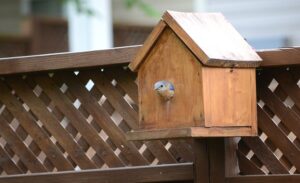
The Eastern Bluebird was on the brink of extinction in the late nineteenth and early twentieth centuries. Habitat loss caused by the invasive species the European Starling and the House Sparrow resulted in bird lovers building nest boxes for Eastern Bluebirds. Then, in 1978, bluebird trails were created, with bluebird nest boxes all along the trails. Today, people still enjoy building these nest boxes to get a close-up view of the Eastern Bluebirds’ everyday life. With human involvement, the Eastern Bluebird population has increased by an average of 2.4% each year. When Eastern Bluebirds migrate north, more than half of the population uses these artificial nest boxes until they migrate back south in the fall.
During the breeding season, males escort females. If the female wants to leave the nest or nest box, she will look around for the male and wait until he gives her the okay and says it is safe for her to leave the nest. While the female is away from the nest, the male watches for predators and communicates with her when things get dicey. Although considered mainly monogamous, males and females will occasionally mate with someone else. This increases the male’s chance of his genes carrying on for generations, while for females, it guarantees that they will have a fertile suitor. Like many other birds, female Eastern Bluebirds have only one ovary, which helps reduce weight while in flight. This is impressive because the female can lay a clutch of up to five eggs and have up to three broods a year! Due to having multiple broods, nesting occurs from March to August. While the female prepares for renesting, the male continues caring for the fledglings from the previous brood. The entire family will stick together until the fall when they join a larger flock to make their way back down south.
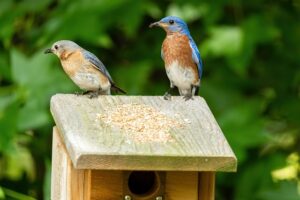
If you would like to learn about other birds migrating to Wisconsin, check out our podcast on this topic later this week. Otherwise, stay tuned as we continue our “First Signs of Spring” mini-series, where we will discuss warmer days with our cold-blooded friends, amphibians, and reptiles.
Thank you to the following sources for the information for this post:
Wild Birds Unlimited – Nature Shop (wbu.com)
https://www.birdadvisors.com/ducks-wisconsin/
https://a-z-animals.com/blog/10-incredible-eastern-bluebird-facts/
https://www.wausaudailyherald.com/story/life/2016/03/30/10-fun-facts-bluebirds/82424314/
https://valparaiso.wbu.com/bluebird-fun-facts
https://journeynorth.org/tm/robin/facts_migration.html
Geese of Wisconsin (10 Species) | Badgerland Birding
25 Types of Ducks Found in Wisconsin! (ID Guide) – Bird Watching HQ
Why do geese fly in a V? | Library of Congress (loc.gov)
Wild Birds Unlimited – Nature Shop (wbu.com)
Wisconsin Migratory Birds | The Nature Conservancy
Eastern Bluebirds Need Your Help – Five Rivers MetroParks

